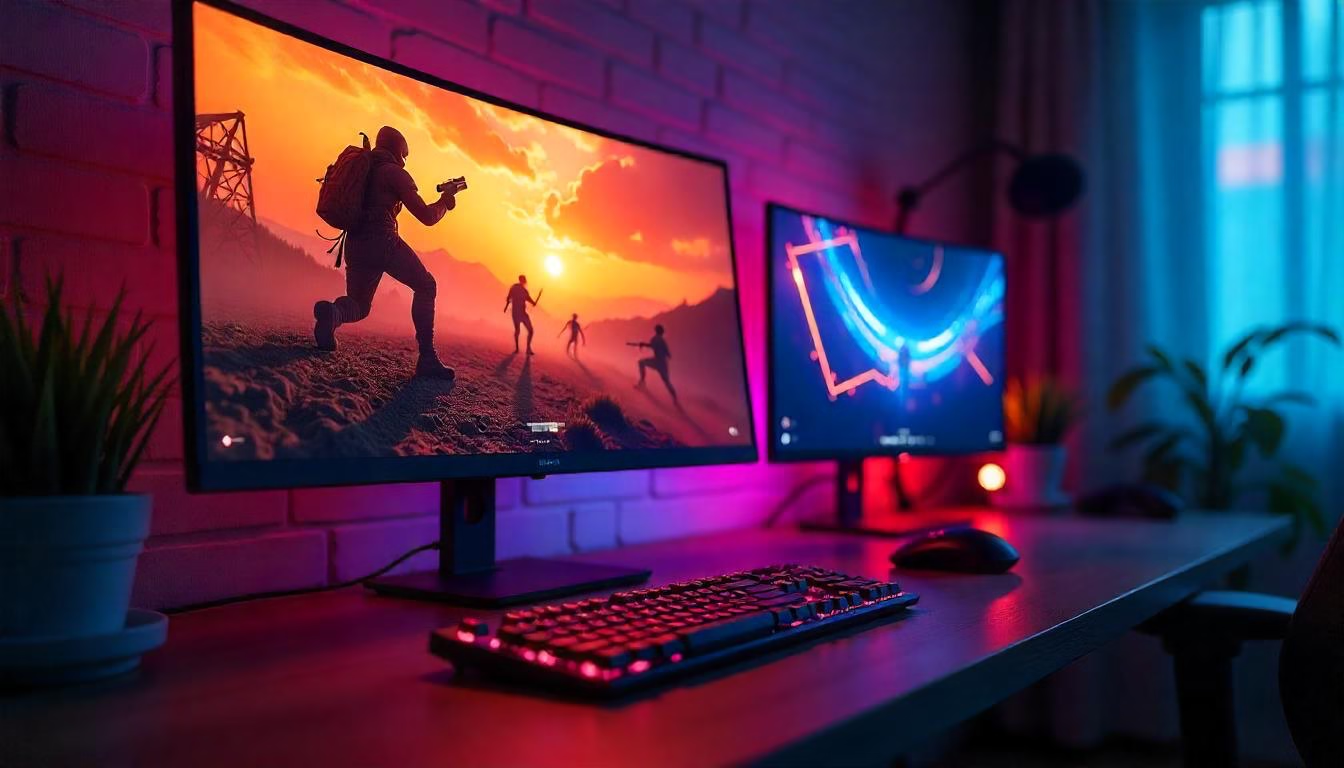Introduction
Building your own gaming PC might seem intimidating at first, but it’s an incredibly rewarding experience. You get to choose every component, customize the build to suit your gaming or streaming needs, and, best of all, save money compared to buying a pre-built system. This guide will walk you through every step — from picking parts to booting up your system — so you can confidently assemble a powerful machine tailored just for you. Let’s get started!
Step 1: Planning Your Build
Before you buy anything, think about what you want from your PC. Ask yourself:
- What games do I want to play? (Casual indie games, competitive esports, or AAA titles?)
- What resolution and frame rate am I aiming for? (1080p at 60 FPS? Or 4K at 120 FPS?)
- Do I want to stream or create content? (This might require more RAM and a stronger CPU.)
- What’s my budget? (Set a realistic number, and leave room for accessories like a monitor or keyboard.)
Step 2: Choosing Your Components
First, you’ll need all the essential parts to build your PC: (The specifics of the following components are recommended for higher-end gaming PC, choose the components according to your needs and budget. More blogs will follow later for specific builds and details on each component and their compatibility with other essentials.)
- CPU (Central Processing Unit): The brain of your computer. For gaming, an AMD Ryzen 7 or Intel Core i7 is a great starting point. If you want to stream, consider CPUs with more cores and threads.
- Motherboard: The foundation of your build. Choose one compatible with your CPU and with enough ports and slots for your needs (USBs, RAM, storage, etc.). (Compatibility blog coming later!)
- RAM (Memory): Helps your PC multitask. 16GB is the sweet spot for gaming, but 32GB is better if you plan to stream or do heavy video editing.
- Storage: You’ll want an SSD for speed (faster boot times, quicker game loads) and an optional HDD for extra space.
- GPU (Graphics Processing Unit): The powerhouse for gaming. NVIDIA GeForce RTX 40-series or AMD Radeon RX 7000-series cards deliver excellent performance. Match your GPU to your monitor’s resolution — no need for a high-end card if you’re gaming at 1080p!
- Power Supply (PSU): Supplies electricity to your PC. Get a PSU with enough wattage for your components, and choose a reliable brand to avoid issues. If confident, a modular PSU is recommended for more freedom.
- Case: Your PC’s housing. Pick one with good airflow.
- Cooling System: Keeps your components from overheating. Most CPUs come with a basic cooler, but if you plan to overclock, consider buying a high-performance air or liquid cooler.
- Case: Houses all your components. Pick one that fits your parts, has good airflow, and has room for future upgrades.
- Operating System (OS): Like Windows 11 — you’ll install this later.
Take your time selecting parts — they all need to work together, and this is the foundation of your entire build.
Step 3: Tools You’ll Need
You don’t need a workshop, but a few basic tools will make assembly much easier:
- A Phillips-head screwdriver (magnetic tip helps with small screws)
- An anti-static wrist strap (prevents static electricity from damaging components)
- Cable ties (for organizing and securing cables)
- A clean, flat workspace (plenty of room to spread out your components)
Step 4: Assembling Your PC
Here’s where the fun begins!
1. Install the CPU: Open the CPU socket on the motherboard, gently place the CPU in (it only fits one way), and secure it. Be careful — the pins are fragile!
2. Add RAM: Find the RAM slots, open the clips, and firmly press the sticks in until they click into place.
3. Mount the Motherboard: Secure the motherboard to the case using screws and the included standoffs to prevent short circuits.
4. Install Storage: Slide your SSD or HDD into the drive bay or mount it to the motherboard (if it’s an M.2 SSD).
5. Add the PSU: Mount the power supply, and connect the necessary cables to your motherboard, CPU, GPU, and storage drives.
6. Install the GPU: Insert the graphics card into the PCIe slot, secure it with screws, and connect the power cables from the PSU.
7. Connect Front Panel Cables: Attach the case’s power button, USB ports, and audio jacks to the motherboard.
8. Organize Cables: Use cable ties to keep everything neat — good cable management improves airflow and makes future upgrades easier.
Take your time with assembly. Double-check connections, and follow the manuals that come with your components if you get stuck.
Step 5: First Boot & BIOS Setup
Moment of truth — power on your PC! If everything is connected properly, the fans should spin, and you should see the BIOS screen. If not, check your connections and make sure all components are seated properly.
In the BIOS:
- Enable XMP/DOCP: This lets your RAM run at its rated speed.
- Check Component Temperatures: Make sure nothing is overheating.
- Set Boot Order: Choose your USB drive (for OS installation) as the first boot option.
Step 6: Installing Your Operating System
Create a bootable USB drive with Windows or your preferred OS, plug it into your PC, and follow the installation prompts. Once the OS is installed, download drivers for your motherboard, GPU, and any other hardware. (Detailed blog will be out later!)
Step 7: Overclocking for More Power
Want to squeeze out more performance? You can overclock your CPU and GPU for higher speeds:
- CPU Overclocking: In the BIOS, gradually increase the clock speed and test stability with stress-testing software (like Prime95).
- GPU Overclocking: Use software like MSI Afterburner to boost clock speeds and adjust fan curves.
Be cautious — overclocking generates more heat, so make sure your cooling system is up to the task!
Step 8: Testing & Benchmarking
Run benchmarking tools (like 3DMark or Cinebench) to test your system’s performance. Stress tests can help you catch potential issues before you start gaming.
Step 9: Troubleshooting Tips
If your PC doesn’t turn on, don’t worry!
- No power? Double-check the PSU switch and wall outlet.
- No display? Make sure the GPU is seated properly and connected to the monitor.
- Error codes/beeps? Check your motherboard manual for error explanations.
Final Thoughts
Congratulations — you’ve built your first gaming PC! 🎉 Not only do you now have a powerful custom machine, but you’ve also learned a valuable skill. The best part? Your build can evolve with you. Want a better GPU or more RAM? Upgrading is as simple as swapping parts.
In future blogs, we’ll dive deeper into individual components — like how to choose the best GPU for your needs or how to optimize your PC for specific games. But for now, power up, install your favorite game, and enjoy the machine you built with your own two hands.
Happy gaming! 🚀
💬 Need Help with Your Build? Let HrWason Handle It!
Building your own PC is super rewarding, but it can also be overwhelming — especially if it’s your first time. If you get stuck, or just want a pro to handle everything, we’re here to help!
At HrWason, we specialize in custom-built gaming PCs tailored to your needs and budget. Whether you want a high-performance streaming rig, a budget-friendly gaming setup, or a themed build, we’ve got you covered.
👉 Here’s how we can help:
- 1-on-1 Build Guidance: We’ll walk you through each step via chat or video call.
- Component Selection Assistance: Not sure which GPU or cooling system to choose? We’ll help you pick the best parts for your goals.
- Full Custom Builds: Don’t want to DIY? We can build and optimize your PC for you — ready to ship or pick up!
📩 Reach out to us:
- Email: services@hrwason.com
- Website: HrWason.com
- Social Media: DM us on Instagram @HrWason
Let us help you turn your dream PC into reality — without the stress!
📩 Want More PC Building Tips?
Subscribe to our blog for updates, detailed component breakdowns, and expert guides on optimizing your rig. We’ll help you get the most out of every build!
Explore HrWason’s blog for expert advice on web development, SEO strategies, digital marketing trends, and the latest in technology, networking, and custom gaming PCs. Stay ahead with tips for building impactful websites and enhancing your online presence.
Designed and Developed by HrWason




2 thoughts on “Ultimate Guide: Build Your Dream Gaming PC Step by Step”